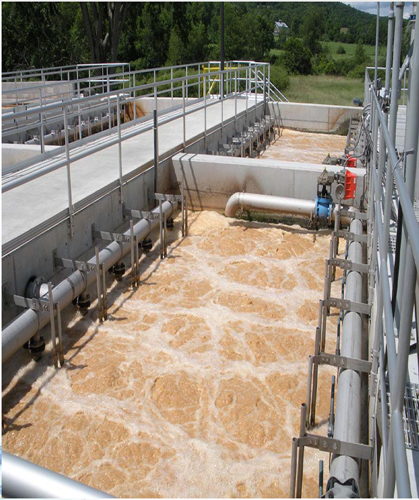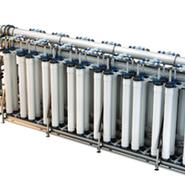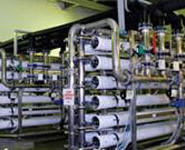Membrane bioreactors for wastewater treatment
Membrane bioreactors (MBR) are modern high-performance biological treatment facilities. Unlike the classical biological treatment scheme with the separation of the sludge mixture in the secondary sedimentation tanks, the membrane bioreactors separate the biological sludge flakes from the treated sewage by filtering the sludge mixture through an ultrafiltration or microfiltration membrane with a pore size of 0.04 to 0.4 micron. The main component of the MBR are cartridges consisting of membrane modules. The membranes may be in the form of a hollow fiber or two flat sheets with a polymeric substrate. The cartridges are immersed directly in the sludge mixture. Using a self-priming permeate pump, a negative pressure is created on the inner surface of the membranes. Due to the difference in pressure on the outer and inner surfaces of the membrane, the wastewater is filtered through the membrane layer. Treated water (permeate) is drained by a filtrate pump. The individual microorganisms (bacteria) of the biological sludge have a size larger than the pore size of the membrane. Therefore, in the filtration process, the biological sludge flakes, free-floating microorganisms and inert suspended substances are retained by the membrane and removed from the surface of the membrane by means of the aeration system.
The MBRs are factory-assembled. The system’s equipment, instrumentation, piping, control and shut-off valves are mounted on a metal frame.
Advantages of the MBRs
- fewer facilities - MBR replaces aeration tanks, secondary sedimentation tanks and sand filters;
- compact size - the concentration of biological sludge in the MBR is several times higher than in traditional facilities, respectively, the volume of the facilities is proportionally several times lower;
- selection of microorganisms capable of oxidizing bioresistant substances - slow-growing microorganisms possessing this ability, due to the membrane, are not washed out of the reactor. Thus, the efficiency of treating hard-oxidizable substances in MBRs is much higher than in the aeration tank system;
- the possibility of year-round nitrification - even in cold climates (in traditional facilities with a decrease in temperature, the growth rate of nitrifiers is reduced and they are washed out of the reactor);
- reliable operation - the work of the facilities does not depend on the sedimentation of sludge (sludge index), its bulking, etc.;
- convenient automation process - the process is entirely automatic;
- disinfection of wastewater - the membrane pores are smaller than bacteria.







